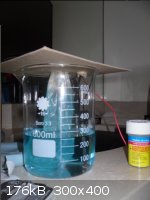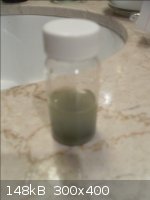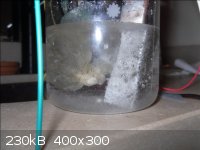DoctorOfPhilosophy
Hazard to Others
  
Posts: 130
Registered: 12-6-2012
Location: Ontario, Canada
Member Is Offline
Mood: enthralled
|
|
Lamb intestine condom = electrolysis diaphragm
I feel like I've slumped back into armchair chemistry, so here is a mini-project for everyone's enjoyment.
Abstract
A condom of lamb intestine was used a diaphragm in aqueous electrolysis. Sodium chloride and copper sulfate were tested. Intestine proved susceptible
to chemical damage, however the results hinted that it may make for effective diaphragms.
Introduction
On my endless search for a suitable diaphragm for electrolysis, I stumbled across this article on the synthesis of (perhaps unfortunately) methamphetamine.
The use of a lamb intestine condom seems ingenious. Clearly, the pores in the intestine are large enough to let small particles through but nothing
larger than a blood cell.
Lamb skin condoms are banned in Canada (the conversation at the sex store was roughly - me: do you sell lamb skin condoms? girls: they are banned in
Canada, we have lots of alternative condoms for allergic people though! me: that's not what I needed it for.... girls: .............. me: "leaves
store")
With the sodium salt, the goal was to measure the effectiveness of the condoms as a barrier (no pun intended) by the sodium hydroxide yield. With the
copper sulfate, the intention was to make sulfuric acid.
Part I: Procedure with CuSO4
The first test that was conducted was with copper sulfate. 6 grams of CuSO4· 5H2O and 300 ml of distilled water were mixed in a
beaker. In a square of cardboard, holes were cut for a cathode and a condom. The condom was partly unrolled and washed in distilled water. Once the
lubricant was gone, the condom was no longer oily to the touch. An aliquot of solution was poured into the condom, and the condom was placed through
the card. The card and condom were lowered onto the beaker. A graphite anode was placed into the condom, and an iron cathode was lowered into the
solution outside the condom (see attachment 2) 14V was passed through the cell until the blue color had changed to green (see attachment 1).
Once electrolysis was stopped, the anolyte was transferred from the condom to a beaker. The graphite electrode had crumbled into the anolyte so the
black suspension was allowed to settle. The resulting liquid was clear. To test for the presence of sulfuric acid, 0.6g of technical grade barium
carbonate was shaken with an aliquot of the anolyte, with plenty of venting. Some CO2 bubbled out and the solution turned cloudy,
confirming the presence of sulfuric acid. Oddly however, the precipitate soon turned dark yellow-green. The rest of the solution remained clear (see
attachment 4).
Originally the copper sulfate electrolysis was done because I assumed that no sulfuric acid would form without a barrier (copper will react with the
acid and create more copper sulfate.) After doing some reading online, I found that it wasn't necessarily the case, so I tested it myself by doing a
control test without a barrier. The first experiment used a iron cathode because I didn't expect it to dissolve in reducing conditions, but it did
dissolve a little. Copper would have been a better choice, but for consistency, I used iron again for the control.
The electrolysis was allowed to run until the cathode (a steel paper clip) was fully dissolved. At that point, the color had gone from bright blue to
light blue. The sulfuric acid test (with barium) gave a very similar result but the precipitate was biphasic (see attachment 3). The top phase was a
yellow-orange liquid. The bottom phase was yellow-green with a hint of suspended particles. There was also a rusty orange precipitate at the bottom.
After this experiment, the condom was permanently stained blue.
Part II: Procedure with NaCl and NaOH
Learning from the copper sulfate test, I decided to try electrolysis with sodium chloride anolyte, sodium hydroxide catholyte, iron anode, and
graphite cathode. The hypothesis was that sodium ions would slowly (since hydrogen evolution is preferred) migrate through the diaphragm to the
cathode and produce the hydroxide. Chlorine evolved at the anode would react with iron making iron chloride. From my experience, chlorine dissolves in
water quite well, so by keeping the chlorine as an anion, it would steer clear of the cathode and catholyte. Since the catholyte is already a
saturated solution of sodium hydroxide, the extra hydroxide should precipitate, indicating qualitative success.
Meanwhile, the condom was stored under MeOH. (I never reuse condoms, but this was an exception!)
Saturated brine was prepared by heating 300ml of water with 107.7g of water. (7.8 g would not dissolve, probably because the water was estimated with
a beaker.) Saturated sodium hydroxide solution was prepared. The dissolution of the hydroxide was much more exothermic than I imagined. The resulting
solution had an unexpected blue tint. When the hydroxide was poured into the condom however, it rapidly (and not surprisingly) disintegrated, ending
the experiment.
Part III: Procedure with just NaCl
The condom from the previous two experiments was now ripped at the tip, so it was inverted and tied off the base, which was undamaged. An aliquot of
the saturated aqueous NaCl was poured into the condom. The cell was set up as in Part I, but the electrodes were swapped (graphite cathode and iron
anode.) As in Part II, the hypothesis was that free chloride would immediately react with the iron anode and be converted back to chloride, keeping it
out of the catholyte.
When current was applied to the cell, the anode immediately began to bubble vigorously. The odor of chlorine was strong (see attachment 5). The cell
was drawing 1.5A from a power supply that could only rated at 0.35A (the variable supply is broken), so a motor was attached in series to increase the
circuit resistance.
To test for the presence of sodium hydroxide in the catholyte, aluminum and magnesium were considered. Magnesium should produce an oxide precipitate
with NaOH, but aluminum is much more vigorous. In a control test with technical NaOH, the magnesium hardly reacted at all, whereas the aluminum
dissolved rapidly. Thus, Al was chosen. Once I did the test however, very little bubbling or dissolution was observed. When I lifted the condom out of
the cell, I discovered it was badly damaged by many little holes.
The final result showed the same biphasic nature as in Part I.
Discussion
In the sulfate experiments, the dissolution of the iron cathode was unexpected and likely complicated the otherwise simple experiment. Dissolution was
fairly slow, but nevertheless a paper clip was dissolved in a matter of 15 minutes. It is likely that the rusty orange precipitate formed during the
barium test of the control electrolyte had something to do with the iron dissolving. A copper or graphite cathode would be much more apt in future
experiments.
Otherwise, the condom seemed to be successful in separating the anolyte from the catholyte. The anolyte was visibly clear while the catholyte was
green. It also kept out whatever substance was causing the upper phase and orange precipitate in the control test.
The anolyte had a greenish/yellowish tint after the barium carbonate was added. This is consistent with some divalent copper compounds, but the true
mechanism of coloration remains unknown to me.
The ill-fated sodium hydroxide test shows that the lamb intestine is unequivocally limited to "gentle" materials. This may seem obvious but it never
hurts to double check.
The strong electrical current observed during the sodium chloride test shows that the lamb intestine is in fact highly conductive to ions. It can not
be known for certain, but it seems as though the holes were caused by a buildup of sodium hydroxide in the catholyte, as expected.
Conclusion
The experiments clearly show that the lamb skin condoms are easily damaged by incompatible chemicals. There is evidence, however, that with the right
electrolyte it could be a workable diaphragm.
Because of the costs and waiting times for obtaining the condoms, future experiments should be carefully planned out an use the mildest possible
chemicals.
Erratum
1) I just realized Part II would not have worked anyway, because the catholyte is saturated with Na+ ions so there is no reason for more to migrate
through the diaphragm. A better way would be to have a little crystal of NaOH in the catholyte (to allow current flow) and then see if more is
produced. The water level inside the condom can be higher than outside, to compensate for osmotic pressure. (I don't know if it's enough though,
probably not.)
2) Despite the broken condom (again, no pun intended) the catholyte from Part III did eventually dissolve aluminum foil, a few hours later.
Perhaps someone can suggest a less damaging cell chemistry to test? Keep in mind the results should be quantitative and preferably comparable
against a control without a diaphragm.
    
[Edited on 17-7-2012 by DoctorOfPhilosophy]
[Edited on 17-7-2012 by DoctorOfPhilosophy]
|
|
|
Hilski
Hazard to Others
  
Posts: 197
Registered: 13-9-2006
Member Is Offline
Mood: No Mood
|
|
Nice experiments.
A few years back, I had a need for a diaphragm for some MnSO4 electrolytic oxidation experiments I was doing. One of the things I tried that worked
was some pieces of Tyvek that I cut from some chemical suits that I had. Tyvek is made from spun high density polyethylene, so it will be inert to
most compounds that we would be interested in electrolyzing. If you decide to go any further with your experimentation, maybe Tyvek will prove to be
a better material than condoms for some electrolytes.
Some of my experimentation is documented in this thread:
http://www.sciencemadness.org/talk/viewthread.php?tid=6882&a...
If you scroll about halfway down, you'll see the part where I started testing the Tyvek.
\"They that can give up essential liberty
to obtain a little temporary safety
deserve neither liberty nor safety. \"
- Benjamin Franklin
|
|
|
DoctorOfPhilosophy
Hazard to Others
  
Posts: 130
Registered: 12-6-2012
Location: Ontario, Canada
Member Is Offline
Mood: enthralled
|
|
Thanks for the tip! Actually I just got a Tyvek envelope in the mail, but I think it's the "Tyvek Solid" with a solid PE layer. Looking at some
microscope images, the fibers are ~20um, a little bigger than they need to be, but I see you posted that it worked. I'll take some nail clippers to
Home Depot and get myself a square of housewrap, it definitely seems worth a try.
|
|
|
Hilski
Hazard to Others
  
Posts: 197
Registered: 13-9-2006
Member Is Offline
Mood: No Mood
|
|
If I recall correctly, disposable tyvek paint suits only cost a few dollars at HD. That's basically what I was using.
***Also, the separators in lead- acid car batteries will work well, if you get them clean enough not to contaminate your experiments. They are spun PE
"pouches" that are made for this specific purpose.
[Edited on 19-7-2012 by Hilski]
\"They that can give up essential liberty
to obtain a little temporary safety
deserve neither liberty nor safety. \"
- Benjamin Franklin
|
|
|
morganism
Hazard to Others
  
Posts: 105
Registered: 8-12-2012
Location: Az.
Member Is Offline
Mood: No Mood
|
|
You might also try rain suit material from Frogg Toggs, they are much more permeable than tyvek.
Cost a bunch more, but they sell em at golf courses, and the seat of the pants rips out fairly easily.
They may have some damaged ones laying around.
|
|
|
violet sin
International Hazard
    
Posts: 1482
Registered: 2-9-2012
Location: Daydreaming of uraninite...
Member Is Offline
Mood: Good
|
|
hmmm, ok guess I am gonna have to grab some tyvek from job sites. or more of a helpful tip: construction workers see this stuff ALL THE TIME. most
houses are wrapped in it. scrap all over the place. so I know it's cheap as paint suits and all. but if you have no cash, a jobsite would be a good
place to ask. and NO ONE would give a $hit or think twice about it. plausable excuse,,, weed barrier for a single outside potted plant, didn't wanna
buy a whole roll. but trust me no one cares. it's always nice to have somethings set aside just in case you wanna tinker but don't have the real
McCoy at hand. IMO jobsites are great places to get all kinds of odd materials for projects. even picked up some lead sheet one time while installing
drywall in a soon to be vet clinic.
|
|
|
|